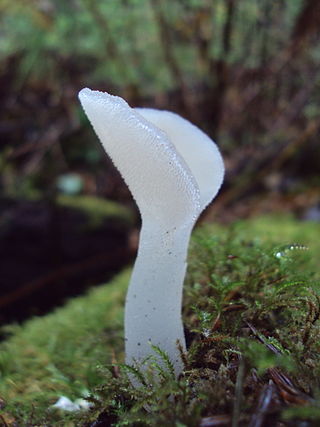
Pseudohydnum gelatinosum is a species of fungus in the order Auriculariales. It has the recommended English name of jelly tooth, with reference to its gelatinous consistency and hydnoid (toothed) undersurface. The species was thought to be cosmopolitan, but recent DNA evidence suggests that it is confined to Europe and northern Asia, with superficially similar but distinct species elsewhere. At least three species occur in North America, but these are currently unnamed. P. gelatinosum grows on dead conifer wood.

The Auriculariales are an order of fungi in the class Agaricomycetes. Species within the order were formerly referred to the "heterobasidiomycetes" or "jelly fungi", since many have gelatinous basidiocarps that produce spores on septate basidia. Around 200 species are known worldwide, placed in six or more families, though the status of these families is currently uncertain. All species in the Auriculariales are believed to be saprotrophic, most growing on dead wood. Fruit bodies of several Auricularia species are cultivated for food on a commercial scale, especially in China.

The Auriculariaceae are a family of fungi in the order Auriculariales. Species within the family were formerly referred to the "heterobasidiomycetes" or "jelly fungi", since many have gelatinous basidiocarps that produce spores on septate basidia. Around 100 species are known worldwide. All are believed to be saprotrophic, most growing on dead wood. Fruit bodies of several Auricularia species are cultivated for food on a commercial scale, especially in China.

The Hyaloriaceae are a family of fungi in the order Auriculariales. Species within the family have gelatinous basidiocarps that produce spores on septate basidia and, as such, were formerly referred to the "heterobasidiomycetes" or "jelly fungi". All appear to be saprotrophic, growing on dead wood or plant remains. Less than 30 species are currently included within the Hyaloriaceae, but the family has not been extensively researched.
Kuwanaspis is a genus of scale insects belonging to the family Diaspididae. They feed on bamboo.

The hydnoid fungi are a group of fungi in the Basidiomycota with basidiocarps producing spores on pendant, tooth-like or spine-like projections. They are colloquially called tooth fungi. Originally such fungi were referred to the genus Hydnum, but it is now known that not all hydnoid species are closely related.

Pseudohydnum is a genus of fungi in the order Auriculariales. Basidiocarps are typically bracket-like and gelatinous, with or without a stipe, with a hydnoid (toothed) undersurface. The genus is widely distributed in both the northern and southern hemisphere, with some seven species currently described and others awaiting description.
Eichleriella is a genus of fungi in the order Auriculariales. Species produce effused or cupulate, waxy to leathery basidiocarps on wood, with a smooth to spiny surface. The genus contains some twelve species.
Heterochaete is a genus of fungi in the order Auriculariales. Species produce effused, gelatinous, waxy, or leathery basidiocarps on wood, partly or wholly covered in small sterile spines or pegs. The presence of these sterile spines distinguishes the genus from Exidiopsis, species of which are microscopically similar but have smooth basidiocarps.

The Ceratobasidiaceae are a family of fungi in the order Cantharellales. All species within the family have basidiocarps that are thin and effused. They have sometimes been included within the corticioid fungi or alternatively within the "heterobasidiomycetes". Species are saprotrophic, but some are also facultative plant pathogens or are associated with orchid mycorrhiza. Genera of economic importance include Ceratobasidium and Rhizoctonia, both of which contain plant pathogenic species causing diseases of commercial crops and turf grass.
Leptenchelys vermiformis, or the slender worm-eel, is a species of eel in the family Ophichthidae. It is the only member of its genus. It is found only in the Pacific Ocean in the vicinity of Costa Rica.
Protomerulius is a genus of fungi in the order Auriculariales. Basidiocarps are formed on dead wood and have an effused, smooth, spiny, or poroid hymenium. The genus is cosmopolitan.
Heterorepetobasidium is a genus of fungi of uncertain familial placement in the order Auriculariales. The genus is widespread, especially in tropical regions, and contains two Taiwanese species, H. ellipsoideum and H. subglobosum.

Lomanotus vermiformis is a species of sea slug, a marine gastropod mollusk in the family Lomanotidae.
Aporpium is a genus of fungi in the order Auriculariales. Basidiocarps are formed on dead wood and have a poroid hymenium. Species were often formerly referred to the genera Elmerina or Protomerulius, but molecular research, based on cladistic analysis of DNA sequences, has shown that Aporpium is a distinct, mainly north temperate genus.
Elmerina is a genus of fungi in the order Auriculariales. Basidiocarps are formed on dead wood and are either bracket-like with a poroid hymenium or densely clavarioid. Species are known from East Asia and Australia.
Protohydnum is a genus of fungi in the order Auriculariales. Protohydnum cartilagineum, the type and only species, occurs in Central and South America and produces effused, cartilaginous basidiocarps on wood, yellow-ochre and wholly covered in small spines. Molecular research, based on cladistic analysis of DNA sequences, has shown that the genus is distinct, but that other species previously referred to Protohydnum belong in the genera Hyalodon or Elmerina.

Myxarium is a genus of fungi in the family Hyaloriaceae. Basidiocarps are gelatinous and effused or pustular. The genus is cosmopolitan. All species grow on dead wood or dead herbaceous stems.
Tremellochaete is a genus of fungi in the family Auriculariaceae. Species produce pustular or lobed, effused, gelatinous basidiocarps on wood, typically covered in small sterile spines or pegs.
Stypellopsis is a genus of fungi in the order Auriculariales. Basidiocarps are effused, gelatinous, crystalline or net-like and occur on fallen conifer wood. Species were formerly placed in Stypella or Protomerulius, but molecular research, based on cladistic analysis of DNA sequences, distinguishes Stypellopsis from these genera and from the morphologically similar genus Mycostilla. The type species occurs in northern Europe, Stypellopsis farlowii in North America.








